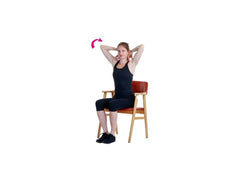Whether you’re a hardcore athlete or an everyday fitness enthusiast, boost your performance and challenge yourself with routine stability exercises.
When fitness is part of your lifestyle, two goals are often front and center: becoming strong and staying strong. As an athlete and coach, I feel called to point out that you are only as strong and as safe as you are stable_. _While the activities we choose and our reasons for staying fit may differ, the benefits of a strong, healthy body are universal. For those of you who may be concerned about the quality of your training, let’s examine why stability work could be an asset you’re overlooking.
Practicing the motor skills needed to maintain posture in an unstable environment, or perform specific movements while your balance is challenged, is necessary for anyone who wishes to remain active and avoid setbacks! So before we sanction stability work to physical therapy, yoga practices or the like, let’s look at a few of the many advantages balance training provides us:
1. Injury Prevention.
There’s nothing worse than an unfortunate injury that interrupts your training. Whether it be a slip and fall or a quick dodge to avoid an obstacle, our reflexes and reaction time play a huge role in protecting us from harm. But did you know that you can work to improve your reflexes? Stability training strengthens the motor neurons that can save you from those injuries caused by the unexpected. Let’s face it, when we love our routine, the last thing we want to deal with is forced time off.
2. Better Total-Body Strength.
Since staying steady in an unstable environment requires coordination, it creates overall postural awareness and improvement. The practice puts greater demand on involuntary muscles, which can help you identify areas of weakness that may have otherwise gone unaddressed. These are the target zones you will want to shore up against those previously mentioned traumas. Better posture has also been shown to improve digestion and breathing, both of which have an influence on athletic performance.
3. Improved joint and ligament health.
Joint strength and protection will impact everyone, eventually. Aging and overuse injuries to muscles and ligaments can put extra stress on your joints. Balance training has been shown to reduce the risk of ligament problems and improve overall mobility. This makes it another promising way to ensure longer-term joint vitality, which will allow you to continue activities for longer without irritation and unwanted setbacks.
While these are just a few perks to practicing stability, the advantages in quality of strength, movement and insurance against injury should motivate any active fitness junkie to break out the BOSU. If optimizing your performance, protecting your body and avoiding setbacks are all important to you, then these six stability drills will supercharge your program and secure a safer, stronger body!

Standing Balance
Exercise: Using the backside of a BOSU balance trainer, stand with your feet shoulder-width apart, keeping your core active, hips level and knees slightly soft. Attempt to level the board parallel with the floor, and hold that position for an extended period. Practice holding for 10 seconds, progressing to 30 seconds and working toward a full minute of near-perfect balance. Tip: Focus on tightening up through the abs to reduce wobbling.
Progression: Replicate this exercise with a single-leg stance.


Balance Squat
Exercise: Beginning from your standing balance position on the BOSU, perform a standard squat, focusing on keeping the balance board level as you sit back. Be mindful that you are able to maintain proper squat form as you move through the exercise, sitting back with some weight in your heels, without your knees extending over/past your toes. Your back is straight, your chest is up and your gaze is forward. Once confident you are able to maintain posture and control, extend your arms into the overhead squat position for an increased challenge.
Progression: Beginning from the single-leg standing balance, work on keeping the board stable while you execute a single-leg squat.

Alternating Balance Lunge
Exercise: Place a BOSU in front of you and begin standing with your feet together, about a lunge-distance behind the BOSU. Step forward with one leg on the BOSU, managing the instability and working on remaining upright. Your bodyweight should be evenly distributed between your front and back leg, keeping your center of gravity through your core, hips and glutes. Your head, neck and chest are upright, and your shoulders and ribs are stacked over your hips. Once balanced, return to the start position by pushing through your front leg. Begin again with the opposite leg, ultimately performing several repetitions, alternating legs each time.
Tip: Try performing both with your hands at your hips and outstretched to the sides. Checking that your arms remain parallel to the floor while outstretched will help you gauge how stable you are through your entire range of motion.

Stability Plank to Push-Up
Exercise: Perform a standard plank with your hands on the top of a balance board. (Resist the urge to grip the handles and sides of the BOSU. The goal is to add instability to your regular plank, so it’s important to simulate the exercise just as you would do it from the floor. Check your form. Your wrists should be under your shoulders, your back should be flat, and your core and glutes should be active. See that you are able to stabilize the board in this position before progressing.
Progression: Keeping the board level, lower yourself down into a push-up, finishing the exercise by pushing up and returning to the plank. Tip: If you struggle to keep your back in good form when pressing up from the bottom, then work first on simply lowering down to the bottom, hovering as long as you are able, and then dropping onto your knees before returning back to the plank.

Balance Plank Variation
Exercise: Place your elbows onto the top of a BOSU and assume a standard plank position. Tip: Start with your knees on the floor while you position your elbows comfortably, then press your toes into the floor and lift your knees gently to properly reach a level plank. Check that your elbows are directly under your shoulders, forming a 90-degree angle with your torso. You should feel a solid burn through your core. Work to increase your ability to maintain this position for extended durations (30, 60 or 90 seconds).
Progression: Rotate into a side plank, dropping to your knees if needed to transition safely. Keep your hips elevated and challenge yourself to open up and reach upward, your gaze following. Your extended hand should be stacked over your shoulders, forming a straight line perpendicular to the floor.

Balance Bird Dog
Exercise: Begin with your knees on the top of a BOSU and your hands on the floor in front of you. Keep a stacked posture — shoulders directly over your wrists and hips directly over your knees, forming 90-degree angles. Resist the urge to rock your hips back because this will defeat the purpose of challenging your hips and core. Begin with lengthening one leg back behind you while maintaining shoulder and hip posture. Be careful not to lift your leg too high or hyperextend your back. Practice this while alternating back and forth between legs.
Note: The balanced leg foot should remain off the floor.
Progression: If you are first able to perform the above without breaking shoulder and hip posture, try lifting your opposite arm. Warning: This is very difficult to do! You should make sure you can perform this exercise successfully on the floor before attempting it on the BOSU.
Written by Darcy DeFrees for Oxygen Magazine and legally licensed through the Matcha publisher network. Please direct all licensing questions to legal@getmatcha.com.






Be the first to comment